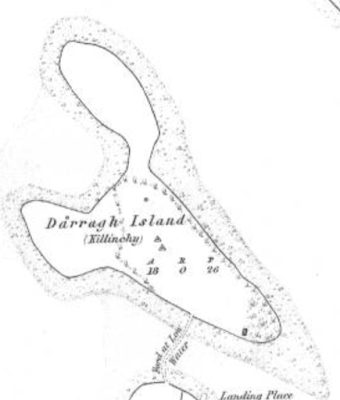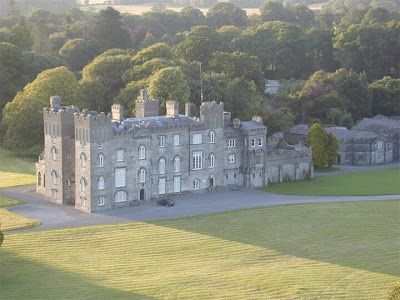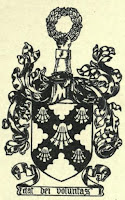THE BARONS DUNSANY OWNED 3,988 ACRES OF LAND IN COUNTY MEATH
The family of
PLUNKETT is supposed (claimed the historian Sir Richard Lodge) to be of Danish extraction.
The time of its first settlement in Ireland cannot be decidedly ascertained, but it was certainly as early as the reign of
HENRY III.
It has extended into many parts of Ireland (particularly the counties of Meath, Dublin, and Louth), and three distinct peerages have been enjoyed by different branches, viz. the earldom of Fingall, and the baronies of Dunsany and Louth.
JOHN PLUNKETT, the earliest of the name on record, appears to have been seated, towards the latter end of the 11th century, at Bewley, or Beaulieu, County Louth, where he died in 1082.
From him descended another
JOHN PLUNKETT, who lived in the reign of
HENRY III, and had two sons,
John, ancestor of the Barons Louth; and
RICHARD, ancestor of the Earls of Fingall; and Baron Dunsany.
SIR CHRISTOPHER PLUNKETT, Knight, grandson of the above-named Richard, was deputy to Sir Thomas Stanley, Lord Deputy of Ireland, in 1432, and subsequently under Richard, Duke of York.
He wedded Joan, daughter and sole heir of Sir Lucas Cusack, knight, Lord of Killeen and Dunsany, by whom he had, with other children,
JOHN, ancestor of the Earls of Fingall, who inherited the lordship of Killeen; and
CHRISTOPHER (1410-63), that of Dunsany, of which he was created, in 1439, BARON DUNSANY.
His lordship wedded Anne, daughter and heir of Richard FitzGerald, of Ballysonan, County Kildare, younger son of Maurice, 3rd Earl of Kildare, by whom he had four sons, and was succeeded by the eldest son,
RICHARD, 2nd Baron, who espoused Joan, daughter of Sir Rowland FitzEustace, Lord Treasurer of Ireland in 1471, and Lord High Chancellor in 1474; and was succeeded by his only son,
JOHN, 3rd Baron, KG, who married Catherine, daughter of John Hussey, feudal baron of Galtrim, and was succeeded by his eldest son,
EDWARD, 4th Baron, who was slain by the rebel O'Connor, 1521, and was succeeded by his son (by Amy, daughter and heir of Philip de Bermingham),
ROBERT, 5th Baron; one of the peers of the parliament held at Dublin, 1541, when he was ranked immediately after his kinsman, Lord Killeen.
His lordship wedded firstly, Eleanor, youngest daughter of Sir William Darcy, Knight, of Platten, vice-treasurer of Ireland, bt whom he had four sons and nine daughters.
He married secondly, Genet, daughter of William Sarsfield, alderman of Dublin, and widow of Mr Alderman Shillenford, by whom he had two other sons.
He was succeeded by his eldest surviving son,
CHRISTOPHER, 6th Baron, who espoused Elizabeth, daughter of Sir Christopher Barnewall, Knight, of Crickstown, and was succeeded by his eldest son,
PATRICK, 7th Baron, who married Mary, eleventh daughter of Sir Christopher Barnewall, Knight, of Turvey, and was succeeded by his only son,
CHRISTOPHER, 8th Baron, who wedded Maud, daughter of Henry Babington, of Dethick, Derbyshire; and dying in 1603, was succeeded by his only son,
PATRICK, 9th Baron (1595-1668), who received a patent of confirmation, from
JAMES I, of the several castles of Dunsany, Corbally, etc.
His lordship was subsequently summoned to parliament in the reign of
CHARLES I, and suffered considerably in the cause of that unfortunate prince.
A short time before 1541, the Lords Justices and supplied the lords of The Pale with arms, but suddenly recalled them, which occasioned much discontent among the Catholic peers, who, having assembled, appointed Lord Dunsany to assure the justices of their attachment and loyalty, and of their readiness to co-operate in every measure that could be conducive to the peace of the country.
The Lords Justices, however, took no further notice of the proffered service than by confining his lordship in Dublin Castle, where he remained for several years; but on the restoration of CHARLES II, he again took his seat in the House of Lords, and continued to sit until 1666.
His lordship espoused Jane, daughter of Sir Thomas Heneage, of Haynton, Lincolnshire, and was succeeded at his decease by his grandson,
CHRISTOPHER, 10th Baron (son of the Hon Christopher Plunket, by Catherine, 4th daughter of Randal, 1st Earl of Antrim); at whose decease,
unmarried, the barony devolved upon his brother,
RANDALL, 11th Baron who, adhering to the falling fortunes of his legitimate sovereign,
JAMES II, was outlawed in 1691; but being included in the Treaty of Limerick, his estates were restored; neglecting, however, the forms necessary to re-establish himself in the privileges of the peerage, neither his lordship nor his immediate descendants had a seat in the House of Lords.
His lordship married firstly, Anne, widow of Theobald, 1st Earl of Carlingford, and daughter of Sir William Pershall; but by that lady had no issue.
He wedded secondly, in 1711, Bridget, only daughter of Richard Fleming, of Stahalmock, County Meath; and dying in 1735, left an only son,
EDWARD, 12th Baron (1713-81), who conformed to the established church, but took no step to confirm the barony and his right to a seat in the House of Lords.
His lordship espoused Mary, eldest daughter of Francis Allen, of St Wolstan's, County Kildare, MP for that county, and had (with two daughters) an only son,
RANDALL, 13th Baron (1739-1821), who claimed, in 1791, and was allowed his seat in parliament.
His lordship married firstly, Margaret, widow of Edward Mandeville, of Ballydine, County Tipperary, and had issue,
EDWARD WADDING, his successor;
Randall (1780-1834);
Margaret; Anna Maria.
He wedded secondly, in 1800, Emma, sister of Sir Drummond Smith Bt, of Tring Park, Hertfordshire, though had no further issue.
His lordship was succeeded by his eldest son,
EDWARD WADDING, 14th Baron (1773-1848), of Dunsany Castle, County Meath.
The heir presumptive is the present holder's brother, the Hon Oliver Plunkett (b 1985).
DUNSANY CASTLE, Dunsany, County Meath, is a modernised Norman castle, begun
ca 1180-81 by Hugh de Lacy, who also commissioned Killeen Castle, nearby, and the famous Trim Castle.
It is possibly Ireland's oldest home in continuous occupation, having been held by the Cusack family and their descendants by marriage, the Plunketts, to the present day.
The castle is surrounded by its demesne, the inner part of the formerly extensive Dunsany estate.
The demesne holds an historic church (still consecrated), a working walled garden, a walled farm complex, an ice house, various dwellings and other features.
 |
| Dunsany Castle (NLI/Robert French) |
Dunsany castle was built, probably in succession to basic "motte" fortifications, remnants of which can still be seen to the left and right in front of it, in the period 1180-1200, construction being thought to have begun in 1180-81.
Foundations and the lower parts of the four main towers are thought to be original, and some interior spaces, notably an old kitchen, but much additional work has been carried out, especially in the 18th and 19th centuries, and the current castle is more than three times the size of the original.
The castle, along with Killeen Castle, was held by the Cusacks, initially on behalf of the de Lacys, and passed by marriage in the early 15th century to the Plunketts.
Originally, it and Killeen lay on a single estate but the first generation of Plunketts gave Killeen to the eldest son, and Dunsany to the younger, Christopher, following which the estate was divided, and the Castle descended in the hands of the Barons of Dunsany, who enjoyed almost uninterrupted ownership, aside from issues around Oliver Cromwell's operations in Ireland (the then Lady Dunsany defended the castle against an initial approach but the family were later forced out, some dying on the way to Connaught), and the aftermath of some other troubles between Ireland and England.
They were cousins of St Oliver Plunket.
The Dunsany estate was reduced by the operation of the Irish Land Acts in the late 19th and early 20th century, but the castle is still surrounded by its original demesne, and other estate lands remain around the district, some adjacent to the demesne and some remote.
Much of the work of the writer Lord Dunsany (18th Baron) was done at the Castle, notably in a room in one of the building's towers.
Dunsany Castle is entered through a projecting porch and a lobby with a worked plaster ceiling, which opens into the central hallway, featuring the principal stairway and a vaulted ceiling, and into a secondary hall.
 |
| Dunsany Castle (NLI/Robert French) |
The ground floor holds the grand dining-room, with portraits of past family members, and a fine arts and crafts billiards-room, as well as kitchen spaces, ancient and modern, and other rooms.
On the first floor are the library, and drawing-room, which has Stapleton plasterwork from 1780.
The library, which may have been worked on by James Shiel, is in the Gothic-Revival style, with a "beehive" ceiling.
Also on this floor is a secondary stairway (where a "priest's hole" for hiding Catholic ministers formerly existed). The third floor holds ornate bedrooms.
The demesne is surrounded by a drystone wall, much of which was built during the Great Famine as a relief work.
There is a full-scale walled garden, over three acres in size, still producing fruit and vegetables for the estate.
A cottage, historically occupied by the head gardener, is built into the walls of the garden.
Nearby are working beehives.
Also within the demesne are stone-built farm and stable yards, an ice-house and wells.
There is a home within the stable yard, and at least one ruined cottage near the walls.





































